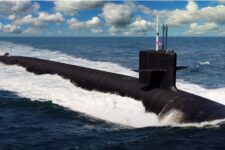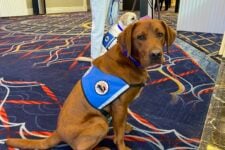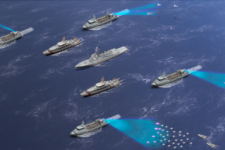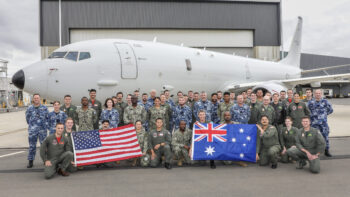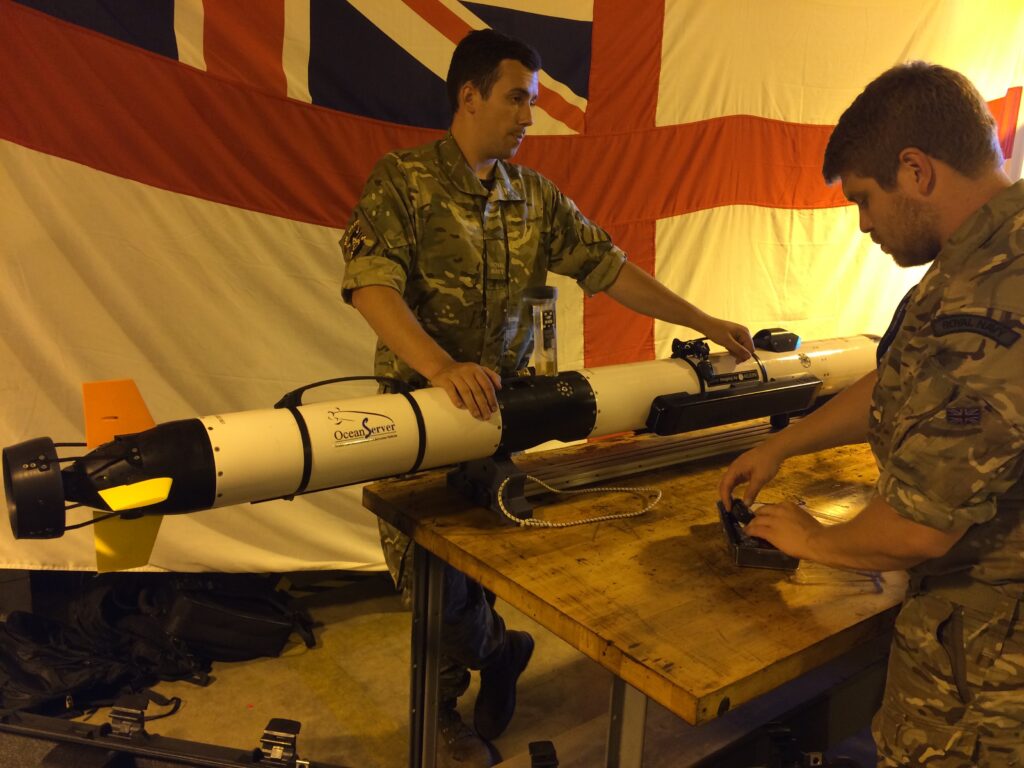
Royal Navy sailors with an unmanned underwater vehicle (UUV) at Naval Air Station Patuxent River
NAVAL AIR STATION PATUXENT RIVER, MD: Pax River is a robot zoo today, showcasing unmanned vehicles from micro-mini-submarines — so small you can throw one like a football — to what appears to be a solar-powered canoe. More than 40 systems here from 30 projects and six nations were gathered by the US Office of Naval Research for a two-week demonstration on combating mines and other underwater problems.
To a civilian layperson with a humanities degree, quite frankly, it’s an awful lot of things that look like torpedoes, most of them bright yellow. But here’s a simple key to cut through the confusion. With an unmanned system, as with people, it’s what’s on the inside that counts.
Don’t get caught up in the size or shape of any of these yellow submarines. Focus on the software — ideally, software that can coordinate different vehicles from different nations.

I don’t know what this thing is, either.
“For this demonstration, we were looking at interoperability,” said Royal Navy Lt. Commander Jacqueline McWilliams, “using two very different systems from two different companies but, by putting the same software on both systems, getting these vehicles to communicate with each other.”
A veteran mine-hunter with experience from the Baltic Sea to the Persian Gulf, McWilliams now leads the Royal Navy Maritime Autonomous Systems Trial Team. MASTT ran an experiment which used software from a firm called SeeByte to coordinate three British unmanned underwater vehicles of two different types, a Canadian UUV, and a British unmanned surface vehicle (USV).
The software, called SeeTrack Neptune, allows the unmanned craft not only to share data but to come to a consensus on a course of action, without human intervention. The operator sets the objective for a group of up to six robots to clear a certain area of mines, for example. Then the algorithms design a plan for how to achieve that objective and then adjust it, if need be, on the fly. If one mini-sub breaks down, for example, the others can divide its tasks among themselves.
SeeTrack is an open architecture, explained SeeByte engineer Pedro Patron, so different companies and governments can customize and even expand it. “Canada and the UK have been exploring different behaviors,” he told me. “For instance, having a surface vehicle acting as a taxi to deploy underwater systems.”
The ultimate objective here is manned vehicles deploying robots that then deploy other robots. This Russian-nesting-dolls approach keeps humans two steps removed from danger. It also speeds up operations, because the frontline robots don’t have to commute back and forth from a manned mothership. The Office of Naval Research initiative to clear mines this way is a package of eight experimental technologies collectively called SS-DTE, Single Sortie – Detect to Engage.

Assorted UUVs (Unmanned Underwater Vehicles) at Naval Air Station Patuxent River
Under the SS-DTE concept, a Littoral Combat Ship or other vessel would stand off at a safe distance and launch an unmanned surface vessel (USV). This robot boat would enter the minefield and launch a first wave of Unmanned Underwater Vehicles (UUVs) to conduct a wide-area sonar search. The sonar UUVs would look, return, and dock with the USV to recharge and upload their data — about a terabyte, far too much to send back via radio. Instead, automated target recognition software aboard the USV itself would look for potential mine sightings and transmit only those manageable chunks of data to the humans for a second opinion.
The humans would send back a list of sites worth closer investigation by optical sensors, at which point the USV would launch a second wave of mini-subs with cameras. They in turn would look, return, recharge, and upload data. Only once the humans had approved a final target list would the USV fire “neutralizers” to destroy the mines.
“It’s just a long and slow ongoing process to where humans will trust machines to make some of the decisions,” said David Jennings, an engineer with the Naval Surface Warfare Center in Panama City, Florida. “Right now, we have what we’re calling ‘supervised autonomy,’ so we will use our ATR [automated target recognition] to select targets of interest, but there still is a human that looks at that potential target set and makes the call.”
So the software’s great contribution is not replacing humans, but winnowing the terabytes of data gathered by drones into something human brains can handle. “Current Post Mission Analysis (PMA) has a mineman sitting and looking at hours and hours and hours of sonar data,” Jennings told me. “Hours and hours and hours of mostly nothingness.”
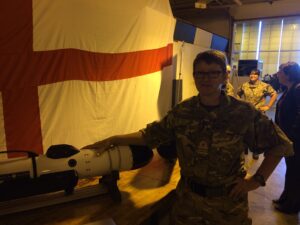
Royal Navy Lt. Commander Jacqueline McWilliams
“The key thing with these tools for mine warfare is getting the man out of the minefield,” but not out of the loop, Lt. Cdr. McWilliams told me. “Keep the [ship] with your experts at a safe distance, send in the off-board systems to do that detailed analysis, bring those back, and then your experts can look at that data and really pinpoint where those threats are.”
It’s an exciting time to be working in mine warfare, and not just because of the new technology. “From a Royal Navy perspective, we’ve always held mine warfare as one of the key facets that we need,” McWilliams said. “America for a number of years edged back on it, but definitely, you guys are coming back into the race.”
Navy is down $1B in munitions from ops in Red Sea, says SECNAV
The dollar figure from the secretary comes as Speaker of the House Rep. Mike Johnson said he is ready to bring the supplemental funding bill the Navy needs passed to the floor for a vote.










